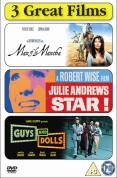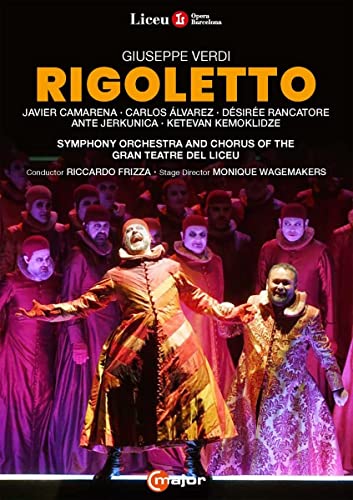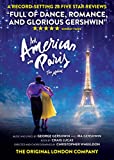![Show Boat [Blu-ray]](/pictures/1154994.jpg) Show Boat | Blu Ray | (23/02/2021)
from £N/A
| Saving you £N/A (N/A%)
| RRP
Show Boat | Blu Ray | (23/02/2021)
from £N/A
| Saving you £N/A (N/A%)
| RRP  Some Enchanted Evening: Richard Rodgers Tribute | DVD | (17/11/2003)
from £4.90
| Saving you £15.09 (307.96%)
| RRP
Some Enchanted Evening: Richard Rodgers Tribute | DVD | (17/11/2003)
from £4.90
| Saving you £15.09 (307.96%)
| RRP This star-studded gala concert hosted by Gillian Anderson celebrates the life and work of legendary Broadway composer Richard Rodgers. Over 40 musicals embedded in the annals of musical theatre history including collaborations with such lyricists as Lorenz Hart and Oscar Hammerstein II are represented here in this joyous celebration of the absolute pinnacle of Broadway music and song. This extravaganza features the best loved numbers from classic pieces of theatre including: 'Bewitched' 'My Funny Valentine' 'I Am Sixteen Going On Seventeen' 'Oklahoma!' and 'You'll Never Walk Alone'.
![Belcea Quartet - Beethoven: The Complete String Quartets [Blu-ray] [2020]](/pictures/1152221.jpg) Belcea Quartet - Beethoven: The Complete String Quartets | Blu Ray | (26/06/2020)
from £28.09
| Saving you £N/A (N/A%)
| RRP
Belcea Quartet - Beethoven: The Complete String Quartets | Blu Ray | (26/06/2020)
from £28.09
| Saving you £N/A (N/A%)
| RRP ![James Blunt: Back Stage [DVD]](/pictures/1112774.jpg) James Blunt: Back Stage | DVD | (03/09/2012)
from £13.48
| Saving you £N/A (N/A%)
| RRP
James Blunt: Back Stage | DVD | (03/09/2012)
from £13.48
| Saving you £N/A (N/A%)
| RRP  Musicals Collection - Man Of La Mancha/Star!/Guys And Dolls | DVD | (28/05/2007)
from £22.98
| Saving you £-9.99 (-76.90%)
| RRP
Musicals Collection - Man Of La Mancha/Star!/Guys And Dolls | DVD | (28/05/2007)
from £22.98
| Saving you £-9.99 (-76.90%)
| RRP Man Of La Mancha (dir. Arthur Hiller 1972): The hit stage musical given the movie treatment. A skinny old gentleman with wispy white hair dreams the impossible dream... He is Don Quixote de La Mancha the knight errant. Don Quixote is the mad aging nobleman who embarrasses his respectable family by his adventures. Backed by his faithful sidekick Sancho Panza he duels windmills and defends his perfect lady Dulcinea (who is actually a downtrodden whore named Aldonza)... Academy Award nominated for best score. Star! (Dir. Robert Wise 1968): Film based on life of actress Gertrude Lawrence on- and offstage takes the opportunity to feature some extravagant musical production numbers... Guys And Dolls (Dir. Joseph L. Mankiewicz 1955): Based on the Broadway show from the Damon Runyon short story and filled to the brim with Frank Loesser tunes such as ""Luck Be a Lady"" and ""Sit Down You're Rocking the Boat "" this outrageously comic film featuring Marlon Brando's bold musical debut is a colorful tale about gamblers a feisty Salvation Army lass and a dance-hall girl with a pining heart. Veteran gambler Sky Masterson (Brando) takes a bet from Nathan Detroit (Frank Sinatra) that he can win the affection of a ""soldier"" (Jean Simmons) in the Salvation Army setting himself up to lose both his money and his heart. Romance is the last thing the gambler and the missionary expect and they fight against their attraction for all they're worth in glowing singing and dancing numbers. Love proves to be contagious as spicy dancer Miss Adelaide in a role re-created for the screen from Broadway by showstopper Vivian Blaine is determined to get her fiance Nathan to the altar one way or another. Stubby Kaye and B.S. Pully also reprise their stage roles in this glorious Cinemascope film that earned four Academy Award nominations. Guys And Dolls consistently ranks among the most popular film musicals of all time.
![Puccini Operas Box [Various] [Opus Arte : OA1240BD] [DVD]](/pictures/1166145.jpg) Puccini Operas Box | DVD | (02/06/2017)
from £N/A
| Saving you £N/A (N/A%)
| RRP
Puccini Operas Box | DVD | (02/06/2017)
from £N/A
| Saving you £N/A (N/A%)
| RRP  Rigoletto | DVD | (16/06/2023)
from £N/A
| Saving you £N/A (N/A%)
| RRP
Rigoletto | DVD | (16/06/2023)
from £N/A
| Saving you £N/A (N/A%)
| RRP ![Follow The Fleet [1936]](/pictures/1011256.jpg) Follow The Fleet | DVD | (04/04/2005)
from £7.78
| Saving you £8.21 (105.53%)
| RRP
Follow The Fleet | DVD | (04/04/2005)
from £7.78
| Saving you £8.21 (105.53%)
| RRP When the fleet puts in at San Francisco sailor Bake Baker tries to rekindle the flame with his old dancing partner... A jamboree for fans of Hollywood musicals with music and lyrics by Irving Berlin.
![Concerto/Engima/Raymonda [The Royal Ballet] [Opus Arte: OABD7272D] [Blu-ray]](/pictures/1152458.jpg) Concerto/Engima/Raymonda | Blu Ray | (17/07/2020)
from £33.13
| Saving you £N/A (N/A%)
| RRP
Concerto/Engima/Raymonda | Blu Ray | (17/07/2020)
from £33.13
| Saving you £N/A (N/A%)
| RRP ![Miss Sadie Thompson [1953]](/pictures/1012342.jpg) Miss Sadie Thompson | DVD | (18/08/2003)
from £6.50
| Saving you £6.49 (99.85%)
| RRP
Miss Sadie Thompson | DVD | (18/08/2003)
from £6.50
| Saving you £6.49 (99.85%)
| RRP Miss Sadie Thompson (Hayworth) is a bawdy night club entertainer stranded on a tropical island during World War II...
![A Midsummer Nights Dream [Various] [C Major Entertainment: 758304] [Blu-ray] [2021]](/pictures/1155735.jpg) A Midsummer Nights Dream | Blu Ray | (23/07/2021)
from £25.65
| Saving you £N/A (N/A%)
| RRP
A Midsummer Nights Dream | Blu Ray | (23/07/2021)
from £25.65
| Saving you £N/A (N/A%)
| RRP ![Grétry: La Caravane du Caire [DVD]](/pictures/1167956.jpg) Grétry: La Caravane du Caire | DVD | (10/01/2025)
from £23.10
| Saving you £N/A (N/A%)
| RRP
Grétry: La Caravane du Caire | DVD | (10/01/2025)
from £23.10
| Saving you £N/A (N/A%)
| RRP ![Annie [1982]](/pictures/1010078.jpg) Annie | DVD | (11/12/2000)
from £8.16
| Saving you £4.83 (59.19%)
| RRP
Annie | DVD | (11/12/2000)
from £8.16
| Saving you £4.83 (59.19%)
| RRP Though it's not in the same league as the classic screen musicals, Annie's heartwarming rags-to-riches storyline, social comment (shallow as it may be) and catchy songs make for an entertaining and unpretentious 90 minutes' viewing. Aileen Quinn is the irrepressible titular orphan, by no means as irritating as she looks in the cover picture; Albert Finney is Oliver Warbucks, the tyrannical tycoon (with a hidden heart of gold, of course) who adopts her for a week in the interests of good PR. The real show-stopper, though, is Carol Burnett as the gin-soaked harpy Miss Hannigan, ruling with an iron fist over an orphanage full of unruly girls, flirting with every man in sight and eventually scheming with her unscrupulous brother (Tim Curry) to kidnap Annie and reap a fat Warbucks reward cheque. While the songs--including "Tomorrow", "You're Never Fully Dressed Without a Smile" and "It's a Hard Knock Life"--are excellent, the kids' voices are shrill and the production pretty low-rent: Annie is very obviously a stage show brought to screen on a low budget. But while it lacks the polish that make the Rodgers and Hammerstein and Lerner and Loewe musicals so special, it's funny and sweet and has a rough charm all its own. On the DVD: The film is presented in widescreen, preserving its original 2.35:1 aspect, and is enhanced for 16:9 widescreen TVs; the soundtrack is Dolby surround, though as noted above the music score is relatively rough and ready so top-notch sound isn't actually as important as it would be in other musicals. The extras are pretty disappointing--an uninspired interactive menu features only the obligatory multi-language subtitles, (very) short biographies of the key cast members, a few publicity cards and posters, the theatrical trailer and--most interestingly--an isolated musical score. No commentary from director John Huston, no documentaries, nothing about the 1930s cartoon strip that was, apparently, one of the most popular of its day. There's actually more information in the accompanying booklet than there is on the disc. --Rikki Price
 An American In Paris | DVD | (20/07/2021)
from £N/A
| Saving you £N/A (N/A%)
| RRP
An American In Paris | DVD | (20/07/2021)
from £N/A
| Saving you £N/A (N/A%)
| RRP ![Glee - Complete Season 1-3 [DVD]](/pictures/1117944.jpg) Glee - Complete Season 1-3 | DVD | (17/09/2012)
from £126.88
| Saving you £-41.89 (-49.30%)
| RRP
Glee - Complete Season 1-3 | DVD | (17/09/2012)
from £126.88
| Saving you £-41.89 (-49.30%)
| RRP Glee is a biting musical comedy that has quickly become a pop-culture phenomenon. It boasts critical acclaim, a loyal fan base of 'GLEEks,' two certified Gold albums, more than 10 million song downloads and an incredible 19 Emmy� nominations--earning it the distinction of being the most-nominated series of the year. Glee follows a group of eager and ambitious students as they strive to outshine their singing competition while navigating the cruel halls of McKinley High. Although New ...
![Matthew Bourne's The Red Shoes [Blu-ray]](/pictures/1156455.jpg) Matthew Bourne's The Red Shoes | Blu Ray | (21/09/2021)
from £15.95
| Saving you £N/A (N/A%)
| RRP
Matthew Bourne's The Red Shoes | Blu Ray | (21/09/2021)
from £15.95
| Saving you £N/A (N/A%)
| RRP ![Royal Wedding [1951]](/pictures/1011612.jpg) Royal Wedding | DVD | (20/09/2004)
from £N/A
| Saving you £N/A (N/A%)
| RRP
Royal Wedding | DVD | (20/09/2004)
from £N/A
| Saving you £N/A (N/A%)
| RRP Brother and sister dance act Tom and Ellen Bowen finish an engagement in New York and journey to London at around the same time as a Royal wedding. On board the cruise ship Ellen meets and falls in love with Lord John Brindale with the result she pays less attention to her dancing. Upon arrival in London Tom auditions for a new partner and meets Anne Ashmond but romance starts to threaten the act...
![Tommy Igoe: Great Hands For A Lifetime [DVD]](/pictures/1151945.jpg) Tommy Igoe: Great Hands For A Lifetime | DVD | (01/01/2000)
from £19.25
| Saving you £N/A (N/A%)
| RRP
Tommy Igoe: Great Hands For A Lifetime | DVD | (01/01/2000)
from £19.25
| Saving you £N/A (N/A%)
| RRP ![Roustabout [1964]](/pictures/1012869.jpg) Roustabout | DVD | (18/03/2002)
from £5.99
| Saving you £7.00 (116.86%)
| RRP
Roustabout | DVD | (18/03/2002)
from £5.99
| Saving you £7.00 (116.86%)
| RRP The Elvis formula was well in place by the time of 1964's Roustabout, a concoction of undistinguished songs (anyone remember "Poison Ivy League"?), pretty girls, tight pants, a colourful setting and a little bit of karate to prove that Elvis really had been studying his martial arts. With that understood, Roustabout is a better-than-average work-out for the King--not as peppy as Viva Las Vegas, but a good deal livelier than the sleepwalking It Happened at the World's Fair. Elvis plays a bad-boy singer roaming the highways on his Japanese motorcycle; laid up after an accident, he joins a carnival owned by the feisty Barbara Stanwyck. ("This is not a circus, it's a carnival. There's a big difference.") The cast goes from high to low: both giant-sized future James Bond villain Richard Kiel and tiny Billy Barty are carny regulars, and Raquel Welch has a small role in the opening scene. Teri Garr is one of the carnival dancers behind Elvis. The legendary costume designer Edith Head puts Elvis in a series of snappy windbreakers, but thank goodness he's also in black leather a lot. As if that weren't enough to recommend it, the movie has a sequence involving Elvis riding a cycle inside the "Wall of Death", a huge wooden cylinder with high walls. This bit actually inspired an entire Irish film in 1986, Eat the Peach, in which friends build a similar contraption after they watch Roustabout on tape. --Robert Horton
![Kenneth Macmillan's Anastasia - Music by Pyotr Ilyich Tchaikovsky & Bohuslav Martin [Natalia Osipova; Marianela Nuñez; The Royal Opera House; Simon Hewett] [Opus Arte: OA1243D] [DVD]](/pictures/1152362.jpg) Kenneth Macmillan's Anastasia - Music by Pyotr Ilyich Tchaikovsky & Bohuslav Martin | DVD | (01/09/2017)
from £20.35
| Saving you £N/A (N/A%)
| RRP
Kenneth Macmillan's Anastasia - Music by Pyotr Ilyich Tchaikovsky & Bohuslav Martin | DVD | (01/09/2017)
from £20.35
| Saving you £N/A (N/A%)
| RRP 
Please wait. Loading...
This site uses cookies.
More details in our privacy policy